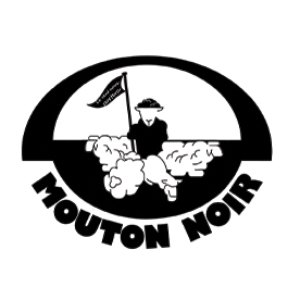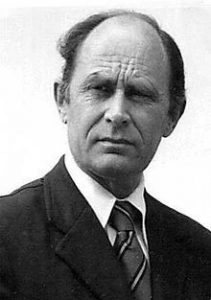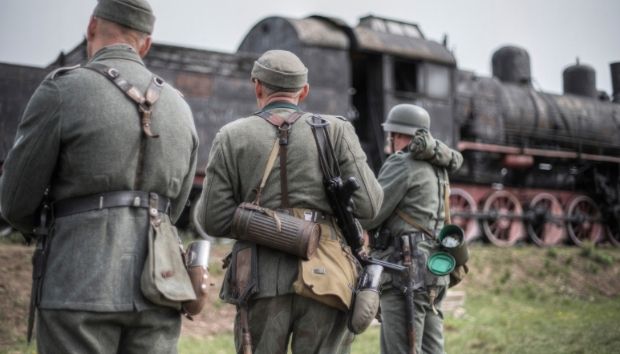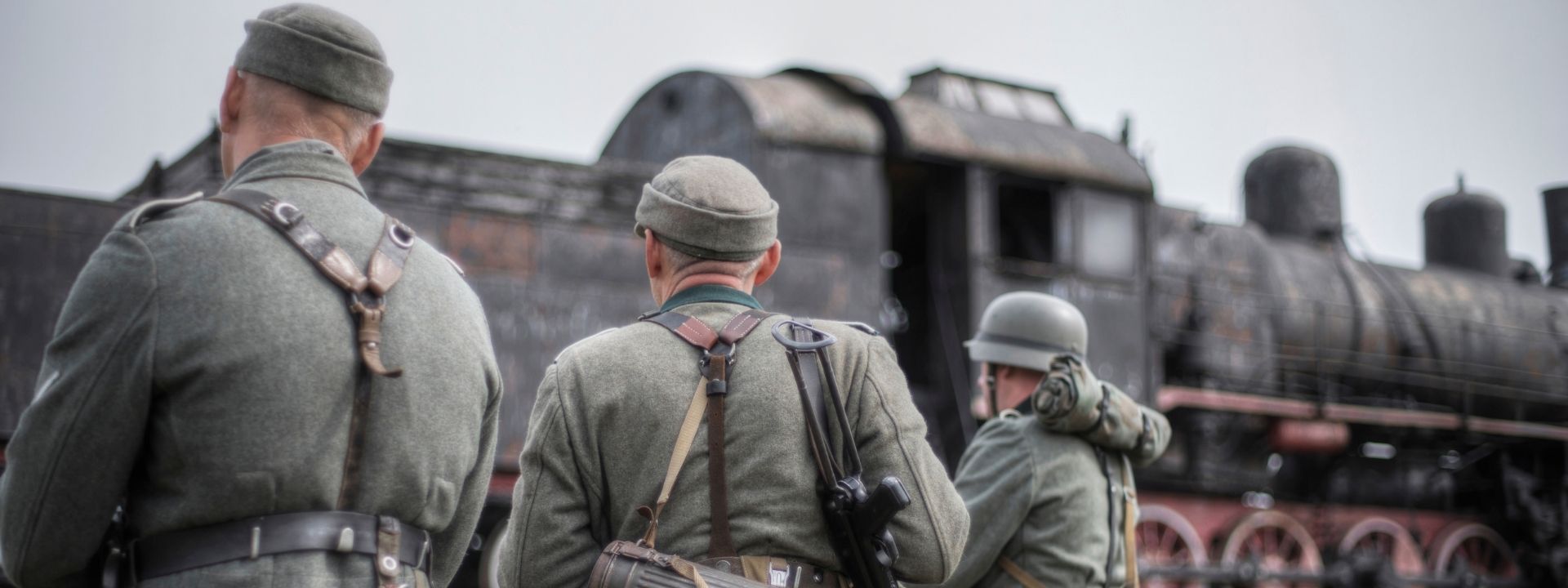One of the main pillars of the “incomprehensible” Blitzkrieg theory maintains that the general staffs, like the Allied politicians, had no knowledge of the German plan, says Manstein, which envisaged encircling the Allied armies in Belgium , and that they were not more aware of the date of the attack.
But nothing could be more deceitful.
In reality, the allies were perfectly aware of all the details of this plan from February 1940.
As for the date and time of the attack, they were communicated to them on April 31, so ten days before May 10.
Non-exhaustive list of information obtained by the highest Allied authorities, before the battle: (excerpt from Volume N°1 of the series The Great Lie of the 20th Century)
Between the end of November 1939 and the end of January 1940, the Allied Intelligence Services noted that the number of enemy divisions on the Belgian and Luxembourg borders increased from 25 to 57.
In addition to this information, they have, as of this date, many other first-hand information:
As early as January 1940, the date of Hitler’s first changes in this direction, General Gamelin was warned by his Belgian military contacts that the forces of the Reich could also attack in the Ardennes.
On January 11, a note from the 2nd Bureau mentions the possibility of German action against the Scandinavian countries.
On January 12 at 9 a.m., General Gamelin urgently summoned his direct subordinate, General Georges commanding the armies of the North, to Vincennes to inform him of the information obtained from Leopold III of Belgium, Pope Pius XII and Count Ciano Italian Minister of Foreign Affairs, indicating the imminence of an attack – January 14 at dawn – against Belgium.
The information was correct, the attack was postponed.
On February 1, the Bern post, which maintained discreet contact with the Swiss SRs exploiting the Roessler network, reported that “the Swiss General Staff is convinced that Germany will, within a few weeks, attack Belgium and the Holland”.
On February 2, source “A”, a young communist whose father was a general and served in the Ministry of War, dealt with by the chief captain of the SR in The Hague, placed this offensive in the spring.
The same day, the post in The Hague collected similar information, however restricting the German attack to Dutch territory but combining it with massive air raids on England.
Correct information, we are a few days BEFORE the final adoption of the German plan, known as “Manstein”, which will bring the main effort to the Ardennes.
On February 17, General von Manstein officially informed Hitler of his plan, and the latter definitively adopted it on the 20th.
A few days later, Lieutenant René Hauth, an officer of the French 5th Bureau stationed in Longwy, in contact with the Luxembourg SRs, was informed of the main lines of this plan, in particular the fact that Army Group A would pass through the Grand Duchy to join the French border. He immediately transmits the information to the highest officials of GHQ in Paris.
On February 26, the corresponding “Ha office” of the Roessler network confirmed the outline of this plan and transmitted it to the Swiss SRs, which would immediately pass on to all the Allies.
On February 27, the source “T”, a young Austrian patriot, treated by the French military attaché in Vienna, Colonel Saland, informed his correspondent verbally: “The successive delays since last November have been the consequence of an opposition hidden from the German generals at Hitler’s will, repeatedly reiterated, to put an end to the West. This one is always firmly decided to attack simultaneously Belgium, Holland and France. At the same time, the Luftwaffe will crush England with massive bombardments.
In the meantime, his immediate objective lies in the seizure of Denmark and Sweden, in order to deny the allies access to the Baltic, to isolate Sweden and to ensure the delivery by this country of the ore essential to the industry. German war. »
This is exactly the general plan of attack in the west.
During the month of March, seven armored divisions will be spotted facing the border and the deployment of the troops will clearly indicate that the main enemy thrust will be exerted in the center of the front, approximately between Sedan and Namur at the hinge of the 2nd and 9th armies. This deployment will be accompanied by all the necessary information:
On March 1, Hitler sends a directive to his generals concerning the future operation in Denmark, an operation combined with that which will be carried out by Falkenhorst against Norway.
In the days that followed, Scandinavia, Denmark and Norway were notified by the Roessler network. Information confirmed by the other agents.
On March 2, according to the French SRs: “an informant in a position to be very well informed about the opinions expressed in the circles of the German High Command, let it be known that a German offensive would be imminent on the Western front; it would include the invasion of Belgium and Holland. »
The same day, the information concerning the invasion of Denmark is retained as accurate by the high command.
On March 8, the Swiss received the first details of France’s plan of attack through the Roessler network.
Following the previous information concerning Poland or Norway, the reliability of the information communicated to ALL the allies (France England, Belgium, Holland etc…) by Colonel Masson, head of the Swiss intelligence service, is not questionable.
On the same day, King Leopold III of Belgium informed his government that all the indications received pointed to a concentrated German thrust: “through the Ardennes in the direction of Dinant – Saint-Quentin, with the intention of cutting off Paris from the allied armies in Belgium and to encircle them in Pas de Calais”.
He instructed his military attaché in Paris to inform General Gamelin and to insist on the “certainty based on convincing documents, that the main axis of the enemy maneuver would be oriented perpendicular to the Longwy – Givet front. »
On March 10, Colonel Delvoie Belgian military attaché received, still from Roessler, therefore from the Swiss SRs, the new measures of the Manstein plan (Fall Gelb N°4) definitively adopted three days earlier by Hitler.
It is specified there that: “the German offensive will be directed on the Meuse, between Charleville and Sedan. The breakthrough will be made through the Ardennes, while the bulk of the German army will fix the bulk of the French, Belgian and British forces on the Belgian border. The tanks of General Heinz Guderian will execute the breakthrough at Sedan, then will pivot in a gigantic sickle blow, in the direction of the lower Somme. They will strive to reach the sea, hoping to trap the bulk of the Allied armies. »
On the orders of his government, Delvoie officially transmitted this information to General Georges’ staff.
All the details of this new plan (number of divisions, distribution plan, material potential, etc.) will be sent to the various Allied HQs between this date and the end of April.
The same day, Colonel Navarre, met in Lugano one of his great agents, Hans-Thilo Schmidt, (alias Ashe) brother of General of Armor Schmidt, commanding the 39th Army Corps integrated into Army Group A. ci confirms that “instead of carrying as planned the main effort of the Wehrmacht on Belgium and Holland” the strongest of the attack would be carried out in the Belgian and French Ardennes and that “the offensive would continue in the direction of the west towards the lower Somme. Thus would be locked up in a veritable trap the Allied forces of the North and of course the Belgian and Dutch armies. »
End of quote (Paillole Our spy at Hitler page 198)
On March 13, Colonel Delvoie received from General van Overstraeten, the King’s military adviser, the order to officially transmit this information to the HQ of General Gamelin, Generalissimo of the Allied Armies and to the staff of General Georges Commander-in-Chief of the Armed Forces. North. He specifies that “according to all the data collected, the main axis of the enemy maneuver was oriented perpendicular to the Longwy-Givet front” but ignores at this time that the French high command already had all this information, transmitted by its military attachés. in Bern.
In the same month of March 1940, seven armored divisions were spotted in positions which allowed them to move westwards south of Liège: “Thus, on that date, the deployment of troops and Panzers clearly indicated that the main enemy thrust would be exerted in the center of the front, approximately between Sedan and Namur, a sector held by the fragile 9th Army. »
On the other hand, the German genius begins to throw on the Rhine, between Bonn and Bingen, eight bridges of boats. These bridges are photographed by Captain Antoine de Saint-Exupéry on an observation mission over Germany aboard his Bloch 141.
As Shirer, who noted these facts, put it: “So many pontoons in the area made it clear where the enemy intended to strike hardest with their armored and motorized troops. The indication became clearer still a few days later, when several other similar bridges were thrown over the Moselle and the Ohr, on the border of undefended Luxembourg, where real panic ensued. »
At the same time, a report by René Marty, staff officer at Gamelin HQ, responsible since January for studying the conditions of arrival of German forces on the Meuse, concluded that the breakthrough would be effective in 48 hours. According to the official version, the report is not taken into consideration: “So as not to demoralize the troops”.
On March 14, Roland de Margerie, chief of staff of Paul Reynaud, president of the Council, receives written confirmation of the plan of attack from Elisabeth Wiskemann, an English journalist with extensive connections in German anti-Nazi circles, in Switzerland and in Italy. . She ends her letter with these words: “Excuse me if you already know all this, but my informant thinks that “es kann sehr bald losgehen” (this may start very soon)
On March 16, agent A 54 of the Czechoslovak SRs, whose real name was Paul Thümmel, a senior German official qualified by the Allies as a perfectly reliable source, having already warned of attacks against Prague, Poland, then Norway, confirmed that Hitler decided to violate the neutrality of Holland and Belgium, to attack France and England, and in turn gives further details of the “Manstein” plan.
On April 3, Colonel Goethals transmitted to the Belgian SRs new information from Colonel Oster, commander of the Abwehr in Berlin. He has been informing the allies for months, and affirms:
“It is wrong to believe that nothing will happen on the western front. I have a deep conviction that it will be unleashed soon. I cannot fix a date, but my personal impression is that 15 April could be the start of an offensive action, led first against Denmark in the direction of Norway and three or four days later against Belgium and Holland. I repeat that I am absolutely convinced of an offensive in the west. »
The next day, April 4, Colonel Oster confirms: “You may not believe me, but a large-scale expedition is being prepared with the aim of occupying Denmark and Norway. The troops destined for Norway are embarking at this very moment at Stettin. The occupation will take place next Tuesday (April 9). The offensive against the West will follow soon after. The operation is a personal initiative of the Führer. The secret has been so well kept that no one except at the highest level knows about it. No more than five other people in Germany at this time. I am the sixth. It is of the utmost importance that Denmark, Norway and England are warned. Do everything you can! »
We will note here that one, at least, of the informants of the Roessler network, who will always be better and more quickly informed than Colonel Oster, must have been part of these “five people”.
We will come back…
General Navarre testifies: “The uncertainty was removed at the very beginning of April by information coming from a very good agent, reporting concentrations of troops and ships in the ports of the Baltic and announcing the imminent invasion of Denmark. and Norway. On April 5 and 6, preparations for boarding in Stettin were detected.
On April 7, the action was deemed certain by the SR”
Concerning the attack in the West he specifies: “From the beginning of April, the rhythm of information of all kinds announcing the offensive went on accelerating. In particular, the following were reported: The construction of bridges and piers on the Moselle and on the Rhine, movements of armored forces, the distribution of maps of Luxembourg and Belgium, the increase in certain depots west of the Rhine, the reduction of civil traffic on the railways leading west, the withdrawal of German planes from Holland, the preparation of crossing points on the Oure and the Sure, the withdrawal of the antennas of the German SR operating in Belgium and Holland.
News situating the German attack across Belgium, Holland and Luxembourg was often mixed with others drawing our attention to the Maginot Line, Alsace or the Swiss border. At no time did the second office and the SR allow themselves to be shaken by these false indications, the character of which was detected as intoxication. »
End of quote (Navarre The intelligence service page 108)
April 11: “Imminent operations in the west, watch out for military movements in the next few days. »
April 12: Captain Paul Paillole of the 2nd Bureau is warned by one of his double agents Schlochoff, who also works for the Abwehr, that the Abwehr 1 posts in Munster and Stuttgart are insistently interested in all topographical details and soldiers in this area and have just entrusted it with the task of surveying the Sedan, Charleville, Saint-Quentin, Amiens axis, the width of the waterways, the condition of the banks, the load-bearing capacity of the bridges and identifying the French troops on the spot, as well as the petrol depots. The agents in charge of this prospecting must provide the elements of response before April 15. »
This is exactly the axis of attack described by Roessler and the other informants.
Captain Paillole is sent to La Ferté sous Jouarre to draw the attention of the head of the 3rd Office (operations) of the North-East command to these disturbing facts. On the basis of the questionnaires, the 5th Bureau (German intelligence) confirms that it may be the main axis of the German offensive. Passing through the Ardennes, it would aim to reach the North Sea.
The date of April 15 also makes it possible to suppose that this offensive could take place at the end of April at the beginning of May, taking into account the time necessary for the exploitation of the information collected.
On April 13, King Leopold III of Belgium insists and asks his military adviser, General van Overstraeten, to confirm to the French military attaché, Colonel Hautcoeur, that according to the information provided by his SRs, Hitler’s tactics will be “to draw the Franco-British into Belgium with the intention of crushing them with an enveloping response, emerging from the Grand Duchy of Luxembourg. He added that it “now seemed obvious to him that the Germans hoped to draw the Allied forces into Belgium and destroy them there from the south, by means of armies coming up from Luxembourg”. Information sent by Hautcoeur the next day.
On April 18, Colonel Gauché, boss of the 2nd French Bureau in charge of gathering and synthesizing intelligence, confirms:
“An excellent diplomatic source reports talks that an informant had with various German military leaders: Hitler ordered to attack Holland and the Maginot Line soon. This action would be combined with an action against Sweden. »
– On the same date, a high German political figure of the Weimar Republic declared that the German command would prepare to attack Holland. The same source reports that an informant, who had already announced the invasion of Denmark, let it be known that the attack against Belgium, Holland and the Western front was to be expected from May 8 in the morning in case of good weather and , otherwise, within a few days. »
End of quote (Colonel Gauché The 2nd Bureau at work)
April 20: “German SR personnel abandon their parking places in Belgium”.
On April 24, Colonel Oster gave the following information:
“The Führer has written to Mussolini that he has decided to start operations in the West soon. Based on the information received and my personal impressions, I believe that the offensive could start next week. »
On April 29, agent A 54 sends the 2nd Czechoslovak Bureau in London the following message, written in sympathetic ink:
“German units and equipment are transported to Italy. Perhaps Yugoslavia will be occupied. Italy sends many units to Albania to enter southern Yugoslavia.
The division into spheres of influence between Germany and Italy was negotiated by Hitler and Mussolini. Feverish preparations for the air attack on England… The USSR is present behind the Romanian border, hence the German pressure on Romania.
The planned military invasion of England is postponed because troops are needed in Norway… When Italy enters the war, Switzerland will probably be invaded… (-)”
All of this information was confirmed to the British SRs throughout this period by another of their direct sources: Agent Sator, stationed in Silesia.
There is therefore no doubt that the leaders of the two allied countries were perfectly informed, since they were cross-referencing their information.
Second essential information: D-Day
In addition to all the provisions of the Manstein Plan, which the Allied high commands now know perfectly well, we come to the second problem posed to their Intelligence Services: The date of the attack.
Remember that it will occur on May 10 at dawn.
Knowing that the official thesis asserts that the SRs will be unable to foresee it until the last minute, let’s see what really happened.
On April 30, the French military attaché in Switzerland, Commander Gaston Pourchot, who since March has been transmitting all the details of the Manstein plan, receives the following information from the Swiss SRs, therefore from Roessler, a source he describes as ” fully authorized and first-hand”: “Germany will attack between May 8th and 10th. Stop. Main axis effort, Sedan. Stop. Planned occupation of Holland and Belgium, northern France in 10 days. Stop. Total occupation of France in one month. Stop. End “
The same day, the information is confirmed:
1° By agent Paul Thümmel (agent A 54) from Prague.
2. By Commander Munier of the French intelligence services in Budapest.
So THREE leading sources, and recognized as perfectly safe.
Finally, “from The Hague, Captain Truttat, who also belongs to the SRs, transmitted the alarms from the Dutch general staff at the end of the evening, as did the naval attaché, Lieutenant Commander Guichard. »
(Berben and Iselin The Panzers pass the Meuse page 78)
Given the importance of the information, Pourchot went in person to Paris to communicate it in more detail to the general staff, to Generals Gamelin and Georges, to the Minister of War Édouard Daladier, and to the Minister of Foreign Affairs, therefore to Paul Reynaud, who combines this office with that of Chairman of the Board, since March 21, 1940.
On the same day, the periodic intelligence conference was held at GHQ in Montry, bringing together French and British specialists, chaired by Colonel Gauché, head of General Gamelin’s 2nd Bureau. Major Maisonneuve, assigned to the 2nd Bureau of HQ Northeast, takes stock of the situation: “Massive action by paratroopers, intense aerial bombardments paralyzing the Allied response, submersion of Holland and Belgium, battle in the open countryside between the German armored fist and the Allied divisions, a dazzling enemy breakthrough taking the Maginot Line from the rear and opening the way to the infantry rushing en masse into French territory. »
Either a perfect summary of the Manstein plan.
On May 1, agent A 54 transmits the same information to his contact in The Hague and specifies: Attack on Holland on May 10.
The information is brought to the attention of the authorities concerned. Thanks to this telegram, the royal family and the Dutch government will not be taken by surprise, and will be able to leave the country in time.
– The many observers on the ground confirm from all sides, and Colonel Gauché, testifies in his book: “During the second half of April and at the beginning of May, the information, by its alarming nature, will be made more and more pressing with the approach of the beautiful days of spring. »
Indeed, concentrations of troops north of the Moselle, facing Dutch Limburg, Belgium and Luxembourg are noted by French intelligence.
– Finally, still on May 1, at the Swedish legation in Belgrade, the German military attaché declared, during a well-watered reception, that the offensive was near, that it would be devastating and that Paris would fall on June 15. . He will only be wrong by twenty-four hours!
On May 2, Captain Paul Paillole of the Counterintelligence Services testified that the English had also been informed by the Swiss and Czech SRs: “The imminence of a German offensive appeared to the English. A meeting of the heads of departments of the second and fifth French and British offices takes place at the British Embassy. Our information is compared with that of our allies. The connections are further strengthened. (-) Bertrand’s services (thanks to the Enigma machine) reveal the preparation of air attacks on our airfields every day. On May 6, the antenna of the German S. R. of Stuttgart installed in Luxembourg folds. On the 7th and 8th, everything confirms the offensive dispositions of the Wehrmacht. »
Knowing that the information transmitted by the agents Roessler and A 54, were communicated to the English, the doubt is not allowed any more: their importance could not in any case have escaped any of the Allies.
This is why, on the same May 2, General Gamelin ordered General Condé: “Enter Luxembourg. Urgent departure! »
On May 3, Colonel Oster of the Abwehr told his friend, Colonel Sas Dutch military attache in Berlin, that General Keitel himself had told him that the attack on the Netherlands and Belgium were planned for the next few days, probably from the 8th if the weather allowed.
Also on May 3, Pope Pius XII, warned by Dr. Joseph Muller, secret representative in the Vatican of Admiral Canaris’ resistance group, asked the Apostolic Nuncio in Brussels and the inter-Nuncio in The Hague to warn the most senior Belgian and Dutch officials: “the German offensive is imminent”.
Expected date: Between May 8 and May 10
On May 4, the Apostolic Nuncio informed the King of the Belgians, and two days later the sovereign pontiff confirmed this in person to Princess Marie-Josée who informed her brother, King Leopold.
On May 5, Mgr Maglione, the Pope’s secretary of state, sent a encrypted telegram to the nuncios of Brussels and The Hague, announcing an upcoming offensive on Holland and Belgium, of which the sovereigns were warned.
The same information is confirmed by the Belgian ambassador to the Vatican who informs Brussels by telephone.
All this information comes from the German Democratic generals.
– The same day, Vice-Admiral Abrial, commanding the Northern Fleet, was warned by the naval attache in Holland. He transmits the information to GHQ. General Giraud, who commands the 7th Army, and the first concerned by the Breda plan, is also informed by Abrial,
Preventively and, according to the State version “on their own initiative”, the two men then ordered the embarkation of troops within the framework of the Breda variant, planning to bring a first contingent of the VIIth Army, to occupy the islands of Zeeland, therefore the mouth of the Scheldt, on the border between Belgium and Holland.
No doubt they intended to start the war on their own, by attacking two neutral countries…
On May 4, 5 and 8, General Headquarters at Vincennes, as well as the heads of the 2nd and 5th Bureaus of General Georges’ staff, received new information from Roessler confirming the imminence of the breakthrough at Sedan and of the sickle blow in the direction of the North Sea, as well as the final details of the operation.
– At the same time, “a reliable source” reports that the Dutch government was advised on May 5, by a very high neutral personality, that a German attack was to be feared at short notice.
– The same source reports that an informant, who had already announced the invasion of Denmark, let it be known that the attack against Belgium, Holland and the Western front was to be expected as early as May 8 in the morning in case of good weather and, if not, within a few days. (I specify that it is about Roessler)
End of quote (Colonel Gauché the 2nd Bureau at work)
Night of May 5-6: The French SRs record: “Next general offensive, which will encompass the Netherlands. »
That same evening, Major Sas Dutch military attaché in Berlin, informed by his friend Colonel Oster of the Abwehr, alerted The Hague that “the invasion is for tomorrow”.
Holland takes immediate action (bridges mined, permissions removed)
On May 6, Colonel Gauché specified that his services had been informed that: “The antenna of the German SR in Stuttgart stationed in Luxembourg is withdrawing. Attack ready. The French army, it is said in the circles of the German command, will be unable to stop the armored formations in open country”.
– The same day, Commander Gustave Bertrand, cipher agent in charge of deciphering the most secret Luftwaffe messages coded by the Enigma machine, warns of preparations for an attack on French airfields.
– Information qualified as “good source” by the SRs, announces in turn: “Next general offensive which will include the Netherlands. »
The same day, the Pope in person receives in private audience Prince Humbert of Piedmont and his wife Princess Marie-Josée of Belgium, to confirm this information to them. She notifies her brother King Leopold of Belgium, who transmits the same information to the French and British governments.
– In the evening, the English ambassador to the Vatican reports to his government: “The Vatican is expecting a German offensive in the west at the beginning of the week. (-) It is also said to the Curia that the operations can extend not only to the Maginot line, Holland and Belgium, but also to Switzerland. »
– Finally, the movements of German troops towards the borders of Luxembourg, Belgium and Holland are confirmed to all governments. That is a total of 73 divisions concentrated on the part of the front going from Kleef to the Moselle.
On the evening of May 6, Colonel Oster contacted his friend Sas, a Dutch military attaché in Berlin, and told him that the planned date for the attack was May 8. “The German forces are in an attack position and could launch the offensive within 12 hours of the final order. The offensive will probably be preceded by an ultimatum to the capitals concerned, in the very short term. »
As usual, he informed the Dutch general staff and General Goethals, Belgian military attaché in Berlin.
On May 7, the antennas of the French SR in Luxembourg communicate the exact objectives of the German paratroopers.
Around 10 a.m., the Auswaertige Amt (German Foreign Office) telephones the Dutch ambassador in Berlin to urgently request diplomatic visas for four important officials who must leave for Holland immediately. Among them are Fritz Todt, the great builder of the Reich, creator of many highways, Richard von Kuehlmann known for having been one of the protagonists of the severe Treaty of Brest Litovsk dictated to Soviet Russia in 1918, and finally a certain Kiewitz “sent Führer staff in the Reich Chancellery”.
This is the delegation that will have to deliver an ultimatum to Belgium.
– Shortly afterwards, still in Berlin, Leonardo Simoni, Ambassador of Italy, receives from the Ambassador of Belgium a note written in pencil advising him that serious reasons oblige him to believe an attack against his country is inevitable and imminent. During the afternoon, notes Simoni, “the concern still grows. A reception takes place at the Swiss Embassy. It’s just dire news flowing from one to the other, faces defeated and upset. In the office of the Italian Embassy there is a veritable procession of officers and agitated civil servants who all bring the same news: Total war is coming! »
Also on May 7, the British agent “Sator” confirms to the London SRs the date of May 10 as the date of the attack.
– In Paris, in the Luxembourg conference room, the former President of the Council Pierre Laval, very surrounded, speaks of the imminence of the German attack.
Note here that Mr. Laval, whom we will find many times during this investigation, seems perfectly informed of the situation, even if according to the official version all his good people will be very “surprised” on the morning of May 10…
– At 3:15 p.m., leave in the Dutch army is abolished.
– In the evening, Oster informs his friend that “the case is postponed for several days”. Major Sas immediately transmits to Dutch and Belgian GHQ.
– At the same time, the French agents in Luxembourg communicate the exact objectives of the German paratroopers.
– Belgian reconnaissance officers are put on pre-alert. Each evening, the blocking devices are closed, and a number of destruction devices are initiated.
– Finally, concerning this day of commotion, General Ruby testifies that, contrary to what the fanatics of “incomprehensible” theses claim: “The aviation was alerted on May 7, by General Vuillemin. !
Which, we will see, will allow the French fighters to lay a trap for the German bombers on the morning of May 10. [1]
On the night of May 7 to 8, a French pilot, Colonel François, returning with his squadron after dropping leaflets on Düsseldorf, reported an enemy armored column more than 120 km long heading with all lights on towards the Belgian border. “The officer promptly made his observation known to his superiors, deeming it of capital importance. They refused to believe it. (Deposition of Daladier at the Riom trial)
On May 8, 1940, two days before the attack, two encrypted dispatches sent to Brussels by the Viscount of Avignon, Belgian ambassador in Berlin, provided further confirmation: the Wilhelmstrasse (Reich Ministry of Foreign Affairs) had finished drafting the ultimatum in the form of an indictment which they have decided to address to the King in order to establish a semblance of legitimacy for their action, and the military attaché affirms that the order to attack in the west just donated by the OKW.
Information that Colonel Gauché testifies to having received:
“the forthcoming arrival in The Hague of three officials from the Wilhelmstrasse who are supposed to be carrying a note or an ultimatum. This information, chosen from among the most important, all indicates the same intention known for many months (emphasis mine) and situates the event around May 10. »
At the same time, the Belgian military attache in Berlin wired that the German Supreme Command had issued the attack order.
At noon, General Delvoie telephoned from Paris to the 2nd Belgian section to announce: “We believe in a possible attack at short notice on the front: Grand Duchy, Belgium, Holland. Reconciliation by embassy. »
Rather surprising this sibylline message in view of the mass of information available to French SRs since April, and apparently the only officially recorded alert communication from French GHQ to its Belgian allies.
– The same day, Colonel Oster, announces to Major Sas the departure of the Führer for the West, in these terms: “The pig has left for the front”.
– The French ambassador to the Vatican, Charles Roux, collects the following information: “Before the end of the week, the forces of the Reich will invade Belgium, Holland and perhaps Switzerland. The invasion of Switzerland is only hypothetical, but the others are announced from reliable sources. »
In his memories, he testifies to having telegraphed to Paris:
“My telegram must have been in Paris on the 8th. I have no doubt that it was communicated to G.Q.G. de Vincennes, who must, moreover, be in possession of corroborating evidence. »
Still, on May 8, the aerial observations of the Allies indicate that many armored vehicles and German troops are moving towards the Ardennes massif.
The general alert is triggered at 11:15 p.m. in Belgium. France and Great Britain are informed.
The aerial observations of the Allies indicate that numerous armored vehicles and German troops are moving towards the Ardennes massif. This is half of the German army, or hundreds of thousands of men, horses and vehicles.
In the aftermath, the bulletin of the 2nd Bureau informs General Gamelin: Alert in Holland, abolition of leaves, recall of leave, accentuation of mobilization measures.
The radio commented widely on the news and a dispatch from the Havas agency reported that President Roosevelt had returned from Hyde Park earlier than expected, “because the situation in Europe caused him concern. »
On May 9, 75 German divisions reached their starting locations. They extend over a width of 400 kilometers and in depth to the banks of the Weser and the Thuringian mountains.
There are 6 armies, 25 army corps, 10 armored divisions, 3 air fleets, an airborne division and commando units; or about two million men, anxiously awaiting the code word “Dantzig”, which will allow them to set off.
That day, in Brussels, after information provided by a German journalist, the director of the press service of the Ministry of Foreign Affairs had the police verify that the German embassy was in the process of destroying by fire all the folders.
The informant clarified that “It starts tomorrow at 5 a.m. (-) I don’t want to be in the bath. He will take the train to Aix la Chapelle in the afternoon.
From the Vatican, the Belgian ambassador reports by telephone to his Minister of Foreign Affairs of the imminence of the attack.
In the afternoon, a clandestine observer informed the headquarters of the SRs at Longwy of the setting up of crossing equipment on the Rhine, and the last message from Roessler and his officer friends was transmitted to GHQ at Vincennes: “Attack the May 10, in the Sedan Gap. Yellow plan maintained. Fifty divisions massed along the Belgian and Dutch borders. Guderian and Hoth ready to rush to Sedan. The dispatch ends with these words: “Hold on! »
In the morning, Colonel Oster informed Sas: “This afternoon, Hitler has set the start of the offensive on the entire Holland, Belgium and Luxembourg front for May 10 at dawn. The order can still be canceled, but not later than 9 p.m. tonight. »
In the evening the two men dine together for the last time and Oster confirms the attack for the next day at dawn.
That same evening, General Ironside, Chief of the Imperial General Staff of the British Army, noted in his personal diary that he had received the information that: “The Netherlands will be attacked in a few hours by the Wehrmacht. »
Around 8:30 p.m., the second section of the general staff of the French army received an encrypted telephone communication from the Belgian military attaché in Berlin, announcing that the invasion was planned for the next day at dawn. However, a counter-order remains possible until 9 p.m. But Colonel Georges calls back around 10:30 p.m. to warn that no cancellation has taken place.
Around 9 p.m., the 2nd section of the Belgian SRs received a cryptogram from Berlin from Colonel Goethals: “Usual informant (i.e. Oster): The Führer decided today afternoon, to launch a general offensive on the front Holland-Belgium-Luxembourg on May 10 at dawn. However, a counter-order, which is still possible, cannot be given after 9 p.m. for technical reasons. Reserve of use. Activity around OKW normal. »
At 10 p.m., Oster comes out of the Wehrmacht High Command, he finds Sas, who is waiting for him outside: “My dear friend, this time, it’s really over, there was no counterorder. »
Information confirmed by Major Sas, at 10:35 p.m.
Immediately the Dutch and the Belgians recalled all the personnel from their headquarters, and launched the general alert.
The last licensees are recalled, the bridges are mined.
In Belgium around 10 p.m., border observers report troop movements, revealing the imminence of the aggression.
The same evening, the representative of the French Intelligence Service in The Hague received the same information: “The attack would take place during the night. Objective, Holland and Sedan”.
He informs his government that “the invasion is for tomorrow”.
At the same time, the Belgian ministers of the Pierlot cabinet meet urgently at the Ministry of Foreign Affairs, and wonder: Should we immediately call for help from France and Great Britain? Finally, they decide to wait.
Which is understandable, they gave the alert to their allies, they will be able to prepare, the essential is done. You might as well let Hitler make the mistake of attacking two neutral countries.
That evening in The Hague, Defense Minister Dijxhoorn and members of Geer’s cabinet separated around 2 a.m.
The Minister will spend the night in his office. As a security measure, his two main collaborators have already been living at the ministry for a few days: “It is better to remain dressed, advised the minister. The message received from Berlin is so positive that we must be ready for any eventuality. »
10:20 p.m., the French ambassador to Luxembourg is warned of the imminence of the attack “at four in the morning” the next day, May 10. The Grand Duchess and her court are packing to take refuge in France.
10:30 p.m., the 3rd Ardennes Chasseurs Regiment goes on alert.
10:35 p.m., Colonel Sas calls Lieutenant-Colonel Post Uyterweer Naval Attaché of the Dutch Defense Minister, and without preamble shouts to him: “Post, you recognize my voice, I am Sas, in Berlin. I have only one thing to tell you: Tomorrow at dawn! Hold on tight ! Do you want to repeat? You know what I mean, don’t you? »
11:45 p.m., “POLUX”, a branch of the French SRs reports to the Central Traffic Office, from Captain Kleinman in Longwy:
“Important movements of German troops on the German-Luxembourg border at Palzem”.
General Navarre testified that “During the night of May 9 to 10, the alert networks (radio stations entrusted to sympathizers and Luxembourg gendarmes) set up by the French SR on the German-Luxembourg border, appeared from 11:45 p.m. The alert was also given by the antennas of Lorraine in Belgium and Holland. »
At 11.30 p.m. in the Netherlands, Queen Wilhelmina and all her family descended into the underground shelter of the royal palace, at the same time the navy and the Dutch army were put on alert and the destruction programmed.
In Belgium on May 10 at 12:20 a.m., the General Headquarters gave the order to be ready to carry out the destruction, and the 750,000 Belgian soldiers were alerted.
At 12:30 a.m., the French ambassador in Brussels, Paul Bargeton telephones Paul Reynaud, who combines the duties of Minister of Foreign Affairs and President of the Council, to confirm the imminent attack.
At the same time, in Luxembourg, the army is put on alert. The Minister of France also telephoned the Quai d’Orsay.
– 1:30 a.m., all Belgian army posts receive the code word: “René”. This is the real alert! The various regiments go up in line from the Meuse to the Ardennes, the airports are alerted and the fort of Eben-Emaël fires the six regulatory cannon shots, to confirm the commotion.
– 2:50 a.m., the Grand Duchess of Luxembourg and her husband leave the capital and head for the French border. It is the road of exile, and of resistance.
At 3 a.m., the German action begins. While the paratroopers prepare to jump on their objectives, the planes take off to bomb Allied airfields.
Shortly after 3:00 a.m., significant aircraft crossings were reported in Belgium, coming from the east. The German bombers invade the sky, the DCA fires. Dijxhoorn personally calls the central air guard service.
– 3:30 a.m., the navy services announce the first bombardments in Waalhaven and Bergen.
– 3:35 a.m. the Luxembourg alert network of Vernier reports the taking possession of the bridges over the Sûre and the Moselle. They will be crossed an hour later by the Wehrmacht.
– 3:45 a.m., in Belgium, the order to fire the road destruction is transmitted to the groups of bomb disposal experts of Saint-Vith, Burg, Reuland, Gouvry and Sommerain for the sector of the 3rd regiment of Ardennes hunters. The first bridges and roads are blown up within minutes.
Finally, at 3.50 a.m. the headquarters of the Dutch land forces at Korte Voorhout announced the thrust of the Panzers in the direction of Arnheim and Roermond, while Colonel van Alphen Deputy Chief of Staff warned General Winkelman: “Crossings of the border at Vaals and Kerkrade. »
France calmly awaits an inevitable shock
“We will win, because we are the strongest” proclaimed Paul Reynaud on September 10, 1939, when as Minister of the Economy, he had just raised the finances of France.
Two months earlier, on July 4, General Weygand had just affirmed in Lille: “I believe that the French army has an even greater value than at any time in its history: it has top quality equipment, first-rate fortifications, excellent morale and a remarkable High Command. »
In those early days of May 1940, American tankers were still unloading tons of oil in French ports, the major refineries were running at full speed, the specially-built strategic tanks were full to the brim, as were the supply and fuel depots. armament.
Millions of men, even if they have been forced to twiddle their thumbs for eight months, know that the end is near and await it with an impatience shared by the whole population: “Let it be over once for all ! »
We find the same determination in the factories that are running at full capacity. President Daladier entrusted Raoul Dautry with the mission of completing the rearmament and silenced any dispute. The sacred union is made. For the past two years, he has eliminated any threat of sabotage or civil coup d’etat, by attacking the hard core formed by the communist leaders under the orders of Moscow, but also the reactionary ultra-right forces. Employers and unions marched, willy-nilly, hand in hand, and the Communist deputies and the nationalist right ended up voting with the same impetus for the credits necessary for intensive rearmament.
Gold reserves are sufficient to pay for arms ordered abroad and ensure domestic production.
As of May 10, dozens of tanks, guns and planes leave the factories scattered throughout the country every day.
France is ready, and awaits the enemy firmly.
The whole of France ? …
With the exception of the entire French army, which is sleeping…
Officially, in Paris, there is no reason to expect an attack.
General Gamelin, Commander-in-Chief of the Allied armies, who went to bed around 10 p.m., is sleeping soundly in his fortress of Vincennes and the General Headquarters seems to have been transformed into the castle of Sleeping Beauty…
Not only have we not sent a single man, not a cannon to the front line to try to fill this breach denounced for months, but everyone is on vacation!
It’s Pentecost weekend and the permissions, logically suspended on April 14, were restored on the 26th. In some units up to 15% of the workforce is missing!
Generals Prételat and Billotte, responsible for the northern front from Dunkirk to Alsace, General Besson who commands the 3rd Army Group stationed in southern Alsace, as well as General Bourret who commands the 5th Army in northern Alsace, are absent.
Of the 94 French divisions on the North-East front, 78 no longer have leaders!
Lack of command which was not without worrying the Secret Services. However, on May 9, at the Army headquarters in Paris, when Commander Baril of the 2nd office suggested to General Colson, head of staff, to recall the leave, the latter gave him this “surprising” response: “Recall the leavers? To do what ? They won’t have to fight tomorrow! Germany is falling apart! »
(Quoted by the encyclopedia “Contemporary France” – 1971)
While the German Democratic officers of the OKH risked their lives to ensure the Allied victory, the same evening General Huntziger, commanding the Second Army on which the full weight of the attack would bear, was at his headquarters in Senuc and prepared to calmly inaugurate the soldier’s home in Vouziers.
Lieutenant-Colonel Paquin, head of the 3rd Bureau will accompany him. While he is getting dressed, one of the men in his service, Captain de Lombarès, informs him that a Belgian civil engineer has just informed him that the German attack is expected for the next day at dawn. .
Paquin’s response: “Okay, put it all in writing for me…”
Before leaving, Huntziger stopped at the headquarters of the 18th Army Corps at Dun-sur-Meuse and entered the third office, where Commander Rollot was watching. That evening, Rollot noted in his travel diary: “Around 8 p.m., General Huntziger came to my office. I tell him that our airmen have taken pictures on the Sûre, that many footbridges there appear to have been recently built. The general replies that it can only be exercises and he adds, a little briskly: “The Germans are not crazy! They are not going to risk putting the 26 Belgian divisions on their ass right now by violating Belgium! “Then he takes his staff to Vouziers, 50 kilometers from Sedan, to attend, in full evening dress, at the Stella cinema, a performance of the army theater: 20 animated songs, directed by Xavier de Courville followed by the comedy: Forced Marriage, play by Molière in one act.
He will join his headquarters in Senuc on May 10, at two o’clock in the morning.
As for Republican General Corap, commanding the 9th Army also involved in the foreground, he is at his post. Awakened at 4:45 a.m. by the warning sirens of his HQ in Vervins, he returned to his office with his orderly Captain Audigier and had his men hurriedly awakened.
However, the alert order No. 3 will not reach him until 6 a.m. and the start-up order will not be given until 6:30 a.m.
Time to wake up the troops and get them ready, most large units won’t move until noon. Either twelve hours late, at best, for the lightest!
When every minute counts…
And this scenario, reoccurring all over the front, heavily penalizes the Dyle-Breda maneuver which planned to block the German advance as quickly and as far as possible.
Thus, the first divisions: 3rd DLC, 1st Brigade of Spahis, and 5th combat tank battalion (BCC) which were to enter Luxembourg as soon as the neutrality of the territory was violated, will only enter it from 7.30 a.m., i.e. four hours after the attack, to find themselves almost immediately facing the advanced elements of the Wehrmacht. French “aid” thus stops just a few kilometers from the border.
According to certain authors who seem to find this quite normal, the Intelligence Services would not have informed the highest French officials of anything.
However, in addition to the information provided by his SRs, it is difficult to claim that the generalissimo did not expect it a little, since on December 16, 1939, when he received his friend Jules Romain in Vincennes, he confided to him: “J ‘imagine that the current period of immobility will be broken by an action in which we will play everything… The decision will then come much faster than we think… Yes, it will be fast and terrible! »
And when Romain asks him about the probable date, his friend replies frankly: “The end of January is not out of the question. Then after reflection: “May. Yes, May. It’s more likely. »
And just as difficult for him and his generals to ignore, the day before, the main headlines of the Parisian daily newspapers: On May 9, Le jour écho de Paris, announces: “Alert in the Netherlands. A real atmosphere of mobilization in Holland. Special precautions have been taken on the coasts. The population is calm. Holland will thus have, after the recall of the pensioners under the colors, the most numerous army that it has ever possessed during its history. The Journal displays on the front page: “Holland, which is mobilizing all its forces, is waiting, sure of itself, for events. »
As for the joke that goes around in the army, it pretty much sums up the general feeling:
– Did you see, the Dutch recalled the leavers?
“Fortunately we are not Dutch…”
These few facts, known to all, illustrate what some describe as an “inexplicably misappropriated view of events”. Admirable understatement…
The king of the tale finally wakes up
It was therefore at 6.30 a.m. that General Gamelin finally appeared.
According to Minart: “His face betrays no apparent emotion, no inner turmoil. The Commander-in-Chief retained that supple calm and that somewhat sweet affability which contributed so much to giving his person that charm of seduction, which those who had only superficial or worldly contact with him were rarely able to resist.
Perky after a peaceful night’s rest, he then sent the elite of the Allied forces to the aid of Holland and Belgium. Right in the trap that he is supposed to know perfectly well even if, even today, historiographers around the world persist in pretending to ignore the reliable and cross-checked information available to his staff.
One of the problems that this investigation will pose for us will therefore be to define to what extent the supreme commander of the Allied armies – whose brain was seriously affected by the devastating effects of syphilis and who was being treated in the greatest secrecy in the military hospital of the Val de Grâce – was or was not informed of the events by the close guard of his staff officers surrounding him day and night in his castle of Vincennes, controlling the visitors as, perhaps, the information he appropriate, or not, to transmit to him. This would allow us to think that Gamelin, placed at the head of the Army by Pétain and kept in his post by Daladier, could have been the appropriate puppet to take responsibility for the defeat.
So, while the latter, seeming totally unaware of the realities, went whistling to give the order to his best divisions to throw themselves into the “Belgian trap”, the German armored columns of army group A, which had become “invisible walk towards Sedan.
[1] See the details of this trap set for the Luftwaffe in volumes 2 and 5 of the series The Great Lie of the Twentieth Century.




















